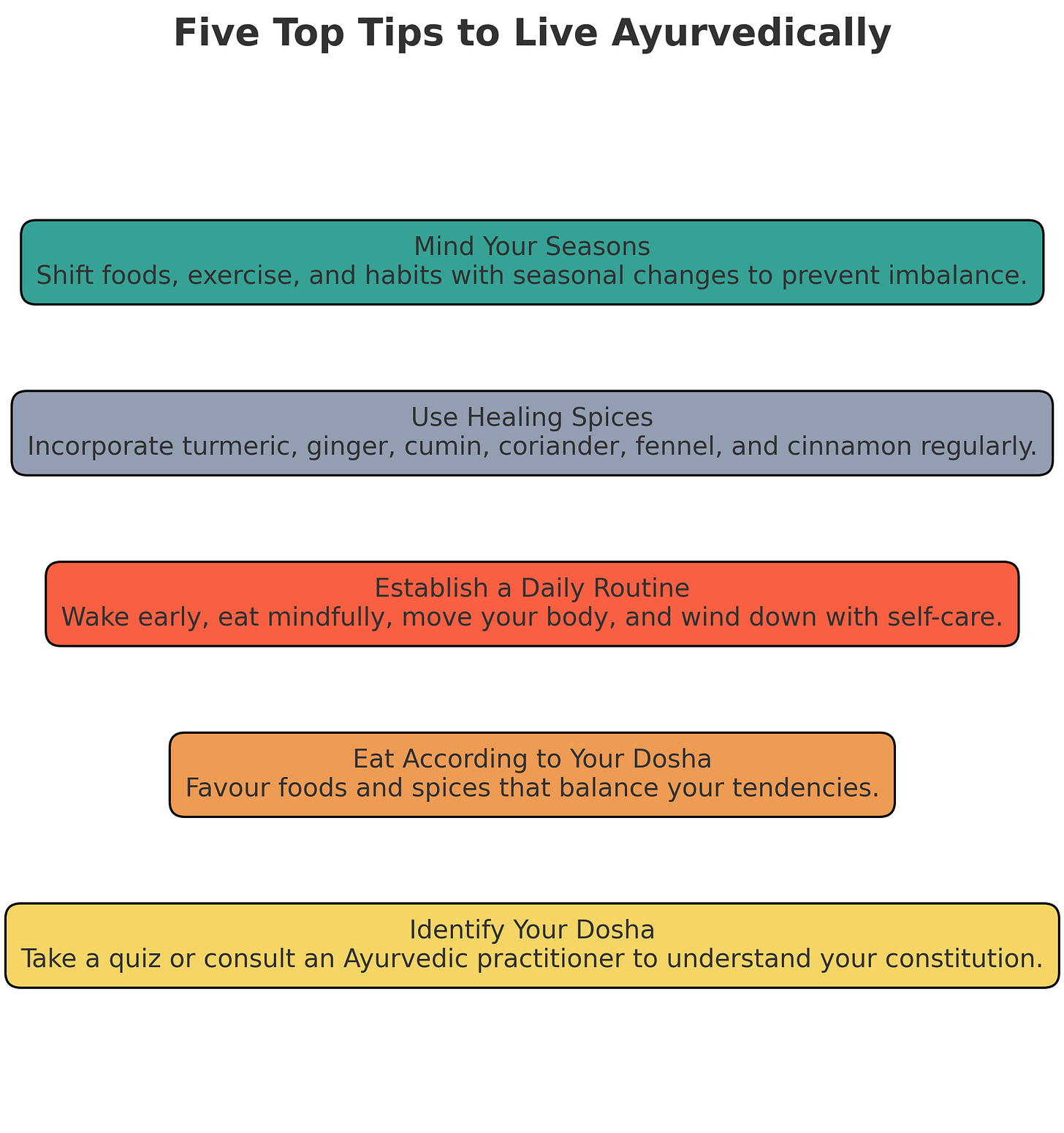So last Sunday, I attended a talk at a local restaurant about ayurveda. I know a bit about it already, and once had an ayurvedic consultation and massage. Probably stupidly, I went for lunch straight after the massage, and puked, gloriously.
Anyway, I’d wisely eaten before the talk on this occasion, and it was so interesting, I decided to dedicate this week’s newsletter to spreading the word. Hats off to the speaker, Vrindavani, [https://www.instagram.com/vrindavanilal/], who managed to keep my interest for two hours, and I still had questions after her enlightening talk.
One of her main takeaways was that living through ayurvedic principles brings glowing health and vitality, and it’s all about achieving balance, eating fresh, organic, seasonal foods, and never eating leftovers older than 24 hours. Pizza for breakfast seems to be off the menu here, folks!
Ayur what?
Ayurveda is a traditional system of medicine originating in India over 5,000 years ago. The word comes from Sanskrit: “Ayur” (life) and “Veda” (knowledge or science), so “the science of life.” It’s not just a system for treating illness, it’s a holistic approach to living, focusing on balance in mind, body, and spirit.
Roots and Philosophy
Ayurveda is rooted in the Vedas, India’s ancient sacred texts.
It views health as a dynamic balance between three fundamental energies, or doshas:
Vata – air and space; governs movement, creativity, and communication.
Pitta – fire and water; governs metabolism, digestion, and transformation.
Kapha – earth and water; governs structure, stability, and immunity.
You can take a free quiz here, to ascertain which dosha/s are predominant in you: https://www.banyanbotanicals.com/pages/dosha-quiz
Every person has a unique dosha constitution (prakriti), a combination of the three doshas, influencing physical traits, personality, and tendencies toward certain health conditions.
Health is maintained by balancing your doshas, aligning lifestyle, diet, sleep, and mental practices with your constitution and seasonal changes.
Living Ayurvedically
Ayurvedic living integrates daily routines, diet, and mindfulness:
1. Daily Routine (Dinacharya):
Wake early, ideally before sunrise.
Tongue scraping and oil pulling for oral health. (Oil pulling is swishing oil around your mouth)
Gentle morning exercise, yoga, or meditation.
Abhyanga (self-massage with warm oil) for circulation and skin health.
2. Eating According to Dosha and Season:
Choose foods that balance your dominant dosha.
Eat warm, cooked, and fresh foods rather than processed or cold.
Mindful eating—avoid distractions and eat in moderation.
3. Mind-Body Practices:
Meditation, pranayama (breathwork), and yoga reduce stress and balance the mind.
Journaling or reflection to track moods, digestion, and energy.
4. Sleep and Rest:
Go to bed early; avoid late-night stimulation.
Naps or restorative breaks can support Kapha or Vata imbalances.
5. Seasonal and Environmental Awareness:
Adjust diet, activity, and self-care according to seasons to maintain dosha balance.
Benefits of Ayurveda
Through eating the foods that are ‘right for your type’, and following the most basic guidelines, you’ll see improved digestion and gut health. Ayurveda allows for people to personalise their diets, while spices like turmeric, cumin and ginger aid digestion.
Our talk host said following the Ayurvedic way will increase your energy and vitality – through adopting certain routines and dosha balancing, you’ll improve your metabolism and sleep.
Next up, there are mental clarity and emotional balance benefits, too – we know that meditation, mindfulness and herbal support reduce stress and anxiety.
You’ll also experience stronger immunity, through the fresh herbs and spices, seasonal diets, and detoxification, all of which support immune resilience.
There’s also the chance to experience holistic healing – following an Ayurvedic lifestyle treats the root cause, not just symptoms, integrating body, mind, and lifestyle.
Five Top Tips to Live Ayurvedically
Identify Your Dosha: Take a quiz or consult an Ayurvedic practitioner to understand your constitution.
Eat According to Your Dosha: Favour foods and spices that balance your tendencies.
Establish a Daily Routine: Wake early, eat mindfully, move your body, and wind down with self-care.
Use Healing Spices: Incorporate turmeric, ginger, cumin, coriander, fennel, and cinnamon regularly.
Mind Your Seasons: Shift foods, exercise, and habits with seasonal changes to prevent imbalance.
Recommended Reading:
Vasant Lad – Ayurveda: The Science of Self-Healing, The Complete Book of Ayurvedic Home Remedies
David Frawley – Ayurveda and the Mind, Yoga and Ayurveda
Robert Svoboda – Prakriti: Your Ayurvedic Constitution
Deepak Chopra – Perfect Health: The Complete Mind/Body Guide (a good introduction)
People and Practitioners to Follow:
Vasant Lad – Founder of the Ayurvedic Institute, New Mexico.
Sadhguru / Isha Foundation – Offers practical insights into Ayurveda and yogic lifestyle.
Dr. Suhas Kshirsagar – Modern Ayurvedic physician sharing lifestyle and nutrition guidance.
Abhyanga-focused Instagram/Yoga practitioners – Many practitioners post daily Ayurvedic routines and recipes.
Ayurveda is about self-awareness, balance, and prevention. By aligning your diet, lifestyle, and mindset with your dosha, you can improve health, energy, and resilience—while cultivating a deeper connection to your body and environment.
A final note: If you’re like me, you’ll get all gung-ho about the joys of an ayurvedic lifestyle, and then fall off the wagon a few weeks later. I think a good approach is to read up on it, discover some new recipes, ways of living and sound advice from 5,000 years ago - and adopt as many of the ideas into your life as suits you. You might not reap all of the benefits, but if you enjoy a certain food every once in a while, that’s a good thing, right? I think it’s all about balance.
Enjoyed this so far? Check out my other posts, share this post, and conssider susbcribing or buying me as coffee over at https://ko-fi.com/willrankin
RECIPES (Ayurvedic meal plan)
Kitchari with Roasted Vegetables
Kitchari (mung beans + rice) is the ultimate Ayurvedic detoxifying and balancing meal, great for Vata and Pitta.
Ingredients:
½ cup split yellow mung beans (washed)
½ cup basmati rice
1 tsp cumin seeds
½ tsp turmeric
½ tsp coriander powder
1 small zucchini, diced
1 carrot, diced
1 tsp coconut oil
Fresh cilantro for garnish
Instructions:
Cook mung beans and rice together in 3 cups water with turmeric, cumin, and coriander until soft.
Roast zucchini and carrot with a little coconut oil and cumin seeds.
Serve kitchari topped with roasted vegetables and cilantro.
Spiced Chickpea and Spinach Curry
High-protein, grounding, and Pitta-pacifying with cooling spinach.
Ingredients:
1 can chickpeas, drained
2 cups fresh spinach
1 small onion, diced
2 cloves garlic, minced
1 tsp ginger, grated
1 tsp turmeric, ½ tsp cumin, ½ tsp coriander, pinch of cinnamon
1 cup coconut milk
Coconut oil for cooking
Instructions:
Sauté onion, garlic, and ginger in coconut oil until soft.
Add spices, chickpeas, and coconut milk. Simmer 10 minutes.
Stir in spinach until wilted. Serve with warm rice or quinoa.
Ayurvedic Vegetable Stew with Lentils
A warming, soothing dish to balance Vata with grounding root vegetables.
Ingredients:
1 cup red lentils
1 sweet potato, cubed
1 carrot, diced
1 tsp mustard seeds
1 tsp turmeric, ½ tsp cumin, ½ tsp fennel seeds
4 cups water or vegetable broth
Coconut oil or ghee
Instructions:
Heat oil, add mustard seeds until they pop, then add spices.
Add lentils, sweet potato, carrot, and broth. Simmer until lentils are soft.
Garnish with fresh coriander and a squeeze of lemon.
Tofu & Vegetable Stir-Fry with Ayurvedic Spices
Light, energizing, Kapha-pacifying meal with protein from tofu and seasonal veggies.
Ingredients:
200g firm tofu, cubed
1 cup broccoli, chopped
1 bell pepper, sliced
1 tsp ginger, minced
1 tsp turmeric, ½ tsp black pepper, ½ tsp cumin
1 tbsp sesame oil
Tamari or coconut aminos for seasoning
Instructions:
Heat sesame oil, sauté ginger, then tofu until golden.
Add vegetables and spices, stir-fry 5–7 minutes.
Season with tamari and serve with steamed rice or millet.
Mung Bean and Pumpkin Soup
Gentle, warming, easy-to-digest soup perfect for ending the week, balancing all doshas.
Ingredients:
1 cup split mung beans
2 cups pumpkin or butternut squash, cubed
1 tsp cumin, ½ tsp turmeric, ½ tsp ginger
1 tbsp coconut oil
4 cups water or vegetable broth
Fresh cilantro or dill for garnish
Instructions:
Heat coconut oil, add spices, then sauté pumpkin/butternut briefly.
Add mung beans and broth. Simmer until soft.
Blend for a creamy texture. Garnish and serve warm.
Tips to Make Your Meals More Ayurvedic:
• Use ghee (you can get vegan ghee, but I’m not sure it hads the same properties) or coconut oil based on your dosha. I use coconut oil.
• Favour warm, cooked meals over raw salads in the evening.
• Add fresh herbs like coriander, cilantro, or fennel for digestion.
• Include warming spices: cumin, coriander, turmeric, ginger, cinnamon, fennel.
That’s all folks - let me know if you try any of the recipes, and remember, live life like you’ve only got one body…





